Content [show]
In the hands of caring gardeners, berry bushes can become a real decoration of the site. The lovingly grown fruits will delight you with a delicious harvest throughout the season.
Fruit trees and berry bushes for the garden
The arrangement of the garden plot is not complete without fruit and berry bushes and trees. In a garden with a beautiful landscape design, there should be a place for a berry bush: raspberries, gooseberries, currants, sea buckthorn, honeysuckle, blackberries, blueberries, irgi. We offer you an overview of the most popular shrubs.
Raspberries
Surely you have heard about the wonderful properties of raspberries. It is difficult to imagine that raspberry bushes used to grow exclusively in forests. And only several centuries later they began to breed it in garden plots. Raspberries have a lot of advantages; they are simply necessary in the garden. Shrubs, depending on the variety, have red berries, less often yellow and purple-black.
Varieties of raspberries
- Traditional varieties of early, middle and late ripening. They adapt to any conditions. The disadvantage is low yield.
- Large-fruited are considered high-yielding. They allow growing berries up to 12 grams each.
- The most popular are repaired. They begin to bear fruit in the first year.
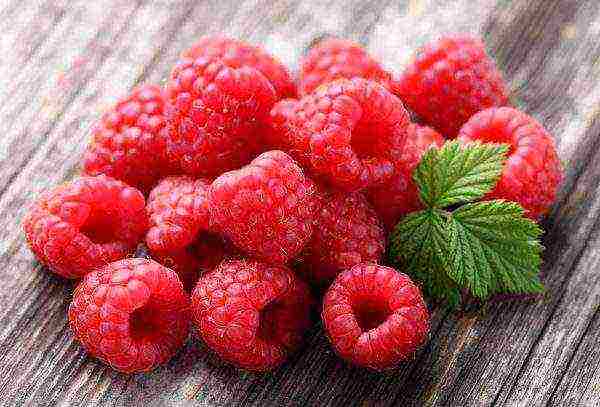 Fresh juicy raspberries
Fresh juicy raspberries
Care features
Berry bush requires regular watering, loosening and fertilization. Planting is done in spring or autumn. For the winter, the soil around the bush is insulated. In the spring it is necessary to trim and tie. All of the above measures will be useless if the shrub is not protected from disease.
Harvest with gloves, since bushes of many varieties have thorns on the branches.
Gooseberry
Gooseberries are often called northern grapes or Russian cherry plums. An unpretentious crop gives good yields. Bushes feel great in lighted areas. They are afraid of shadows and waterlogging. You can find gooseberries in almost all regions. Bushes begin to bear fruit from the third year. The berries can be green, yellow, or reddish-brown. There are at least 1500 varieties
Unlike currants, gooseberries are not afraid of drought.
Gooseberry varieties
- European varieties are praised for their high taste. The disadvantage is the instability to disease and frost.
- American - are not afraid of drought, give a good harvest. In terms of size, the berries are inferior to European varieties.
- Hybrid - combines all the best. In garden plots, they are considered the most common.
Care features
Gooseberries do not tolerate acidic soils; it is recommended to add garden compost and lime to the planting trench. Bushes are planted in September. When planting in spring, the plant may die. Old and dry branches must be pruned. Collect gooseberries as they ripen. Due to the thorns on the branches, it is better to do this with gloves.
 Red gooseberry
Red gooseberry
Blackberry
In the garden, blackberries are grown relatively recently, before they could be found exclusively in the wild.
In terms of healing properties and taste, it surpassed raspberries. A shrub with a perennial rhizome was not in demand due to its sharp thorns. However, thanks to breeders, varieties without thorns have appeared. It has an external resemblance to black raspberries. It tastes sour.
Blackberry varieties
- Erect blackberry - is considered the most common. The bushes give a good harvest and save space on the site.
- Semi-creeping varieties are extremely rare. Experienced gardeners recommend planting this particular variety.
- Repaired blackberry - allows you to harvest 2 crops per season: June, August.
Care features
It gives a rich harvest on well-fed land. In erect varieties, it is necessary to tie up young stems. Planting blackberries is carried out in a trench strictly along the line, otherwise there may be difficulties in care. During the fruiting period, the bushes need to be watered abundantly.
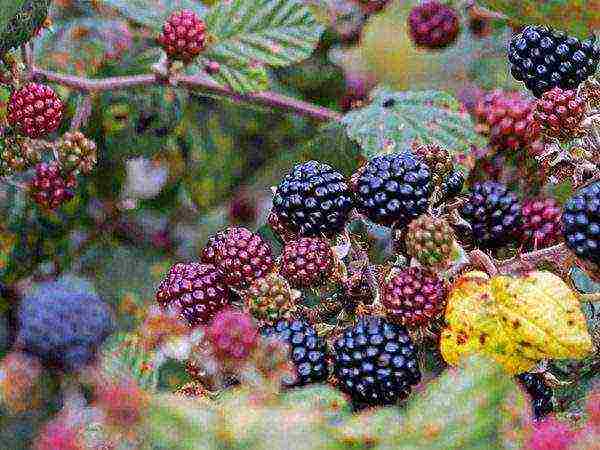 Juicy blackberries ready to harvest
Juicy blackberries ready to harvest
Honeysuckle
Edible varieties of honeysuckle are popularly called "rejuvenating berries". The name did not appear by chance, since the berries contain an element of youth - selenium. Shrubs bloom beautifully, so they are often used for decorative purposes. However, to a greater extent, the berry is valued as a useful storehouse of vitamins.
It ripens in mid-May. The berry has a slightly bitter specific taste.
Honeysuckle varieties
- Long-fruited honeysuckle - medium-sized bushes are distinguished by the cylindrical shape of the berries.
- Hybrid varieties - bred by breeders by crossing berry varieties.
- Mid-late varieties - allow you to harvest honeysuckle until late autumn.
Care features
Bushes do not tolerate shade well. When choosing a place for landing, it is better to give preference to sunny places. Suitable for planting both in autumn and spring. In the spring, this must be done before the start of the growing season. Honeysuckle grows slowly so that the bush takes root and fructifies well, it is fed.
Bushes 6-8 years old require sanitary pruning. Dead branches must be removed... Young shoots do not need to be cut.
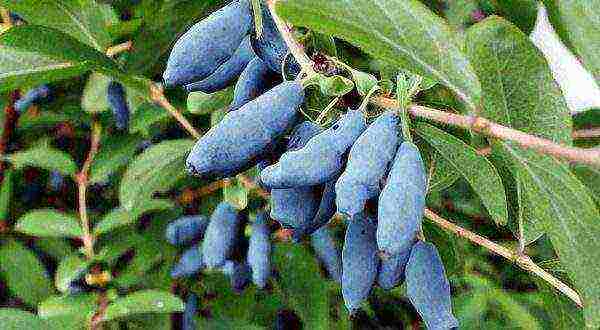 Honeysuckle berries on a bush
Honeysuckle berries on a bush
Currant
Perennial currant bushes can be found in garden plots and plantations. Berries are famous for their taste and useful properties. Bushes, unpretentious to care for, allow you to collect rich harvests. It is almost impossible to choose one single variety for the site. The best option would be to grow several species at once. Saplings adequately overcome the harsh cataclysms of nature in a cold winter.
Varieties of currants
- Black currants of early, medium and late ripening. Large-fruited varieties are considered the most popular.
- Red currant - differs in more weighty bunches. Bushes can grow without transplanting for up to 20 years.
- White currant - a variety in taste and benefits is not inferior to red.
- Hybrid varieties - bred by breeding gooseberry and currant varieties.
Care features
Produces a good harvest in well-drained soil. Cannot be planted in an acidic environment. Loosening of the soil is required during the growing season. Do not allow the soil to dry out; in dry weather, it is necessary to provide watering.
In the fall, you need to rejuvenate the bushes by pruning outdated branches.
 Black currant harvest
Black currant harvest
Blueberry
In many regions, it is considered a rare berry. Most often it can be found in the wild. There is a growing interest among gardeners in growing promising varieties on their plots. Thanks to proper care, you can have a good harvest of healthy berries.
Blueberries resemble blueberries in appearance.
Blueberry varieties
- Tall varieties - feel good as a hedge. Their bushes are branched, the berries are intense, blue or blue.
- Low-growing blueberry - blooms magnificently in spring, pleases with excellent harvests and the neatness of the bushes.
- Southern varieties - were eaten away by hybridization for cultivation in arid climates.
Care features
At home, it is better to grow not wild, but more adapted cultivated varieties. Bushes take root well regardless of the method of planting by seeds or dividing the bush. Pruning is carried out on adult bushes, starting from 5-6 years of plant life.
Blueberries are very picky about the soil, they need to create fertile conditions.
 Bunch of blueberries
Bunch of blueberries
Sea buckthorn
Sea buckthorn bushes can be found near water bodies, which is why they are often called "sea thorn". Experienced gardeners manage to successfully grow it in their plots. The use of berries is very wide, they are mainly used for medicinal purposes. Sea buckthorn oil is considered especially valuable.
Varieties of sea buckthorn
- Early, middle and late ripening - garden varieties of sea buckthorn.
- Botanical variety - practically has no thorns.
- Large-fruited varieties are sweeter in taste, do not have thorns.
Care features
The bush will bear fruit if a female and male specimen of sea buckthorn is planted next to... For the winter, it requires shelter of the soil, it does not tolerate severe frosts very well. Pruning is carried out in the spring. A bush aged 8-12 years old requires rejuvenation under the stump. Watering the plant is not necessary, unless in a drought.
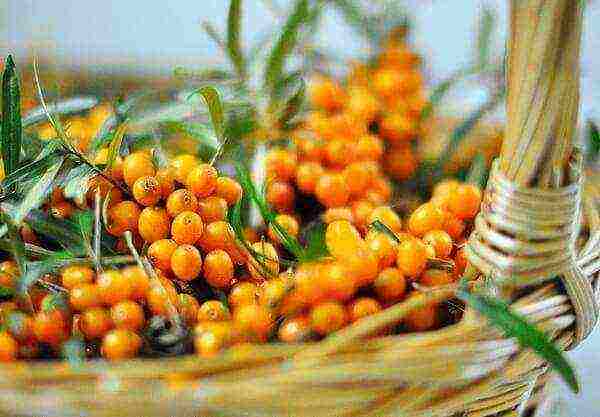 Harvested sea buckthorn berries
Harvested sea buckthorn berries
Irga
A beautiful plant is often used as an ornamental shrub. And only a few people know how useful berries grow on it. Having once tasted irgi berries, the gardener will definitely want to plant a bush in his area. The plant is not only useful, but also winter-hardy, withstands harsh weather conditions.
To the taste, dirge berries are somewhat reminiscent of cherries.
Irgi varieties
- Alder-leaved irga is a shrub that blooms profusely in spring. In autumn, the leaves are painted with a bright color. From a plant, you can get up to 10 kg of berries.
- Canadian Irga is a tall, tree-like shrub. The berries are fleshy and tasty.
- Irga blood-red is a slender, medium-sized shrub. The berries are very juicy, with a thin, delicate skin.
Care features
It is considered an unpretentious plant, practically does not require maintenance. Shrubs love abundant watering, especially during the growing season.
The first 2-3 years it is necessary to form a bush by cutting. At a later age, the plant is rejuvenated.
Berries attract birds, the crop must be harvested in a timely manner as they ripen.
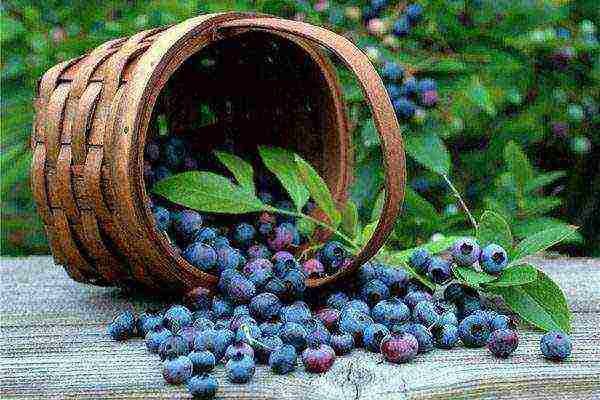 Basket with irga
Basket with irga
By planting several varieties of shrubs, you can diversify the assortment of fruit seedlings in the garden. Regarding the choice of plants, it is so great that it will not be possible to advise anything with certainty. Species and varieties must be selected taking into account the individual characteristics of the plants.
If you want to dilute the usual row of apple trees, pears, gooseberries and raspberries on your site, take note of our selection of not the most common fruit trees and berry bushes. All of them can be planted in the fall!
September-October for a summer resident is still a "hot" planting season. If by next year you want to diversify the standard fruit and berry "assortment" of the summer resident with not the most popular plants, our article will help you make the right choice. We show rare shrubs and tell you how to grow them in the middle lane.
Apricot
Perhaps the apricot is the most trivial plant on our list. Yes, this is a southern tree. Yes, it often freezes out in the cold winters of the middle zone. But, nevertheless, many gardeners manage to get an excellent harvest every year with frost-resistant apricots: Iceberg, Alyosha, Aquarius, Countess, Lel, Northern Triumph, etc.
The main secret of growing this crop in conditions far from the hot south is the right choice. seats for landing... Be sure to choose a site that is well protected from the winds on the south or southwest side of the garden. Drafts, cold and waterlogging are the main enemies of apricot.
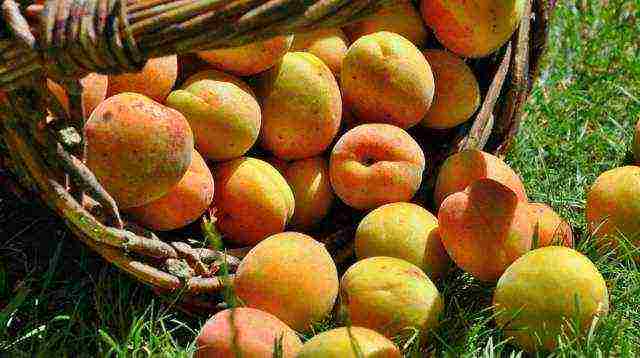
The harvest of apricots can please even in the middle lane
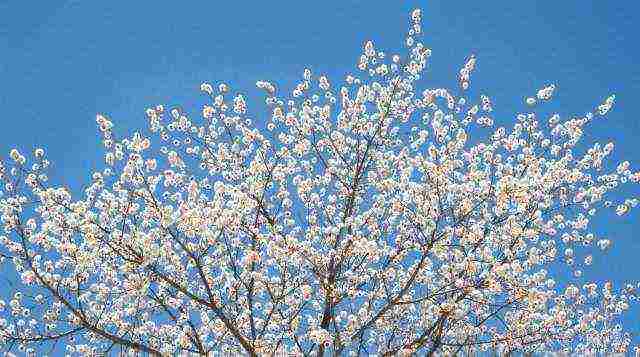
Blooming apricot will decorate any garden

Apricot is considered one of the most common in the middle lane of southern trees.
Soil fertility is not the most important factor when planting an apricot, but for a thermophilic "guest" it is advisable to prepare soil mixture from peat, clay and sand, taken in equal parts. Rotted compost and dolomite flour can also be added here.
They choose a place for planting an apricot and begin to prepare it in the fall in order to plant a seedling at the end of April.
The size of the planting pit should be at least 70 × 70 cm. The apricot is planted so that the root collar of the seedling is a few centimeters below the soil level.
If the groundwater in your area is too close to the soil surface, the usual planting method for apricots will not work. Some experts recommend plant apricot seedlings in earthen mounds with a diameter of 2-3 m and a height of about 1 m. Plus, such a "flower bed" will help protect the tree from waterlogging during snow melting.
Despite the fact that the apricot tolerates dry air quite well, regular watering is still important for it. It is imperative to water the tree during planting and transplanting, 2-3 weeks after flowering and about a week before the fruit ripens. Naturally, in abnormal heat, the apricot is watered more often. The watering rate for an adult tree is 40-50 liters of water, in a drought - 70-75 liters.
From the end of July, watering begins to gradually stop, so that the shoots have time to ripen by winter.
Gumi (multiflorous goose)
Gumi (aka many-flowered sucker) is an unusual berry shrub with beautiful silvery leaves and bright red fruits. It is covered with fragrant white flowers in spring, and yields in the first half of August, 4-5 years after planting. The taste of the berries is pleasant, with a slight sourness.
Gumi flowers are bisexual, so ovaries will appear even on a single bush, although it is still preferable to plant at least 2-3 plants nearby.
Planted multiflorous oak tree at the end of April. The place is selected in the same way as for an apricot - warm, not blown by winds, without stagnant water.
When planting, the seedling is buried so that the root collar is 5-8 cm covered with earth.
Another name for gumi is multiflorous goose
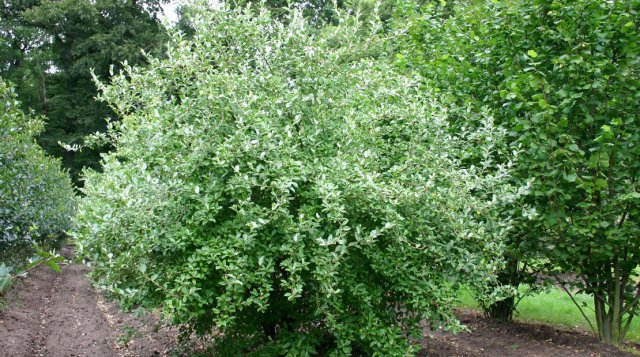
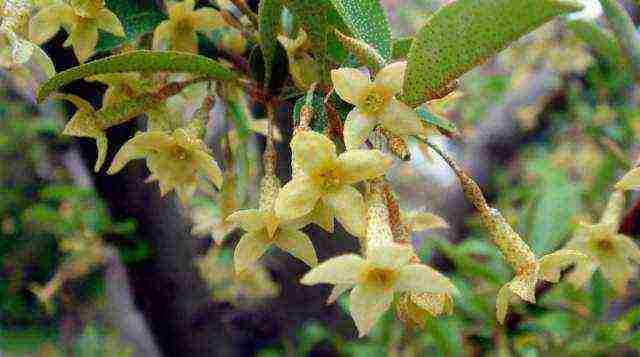
Blooming oak multiflorous
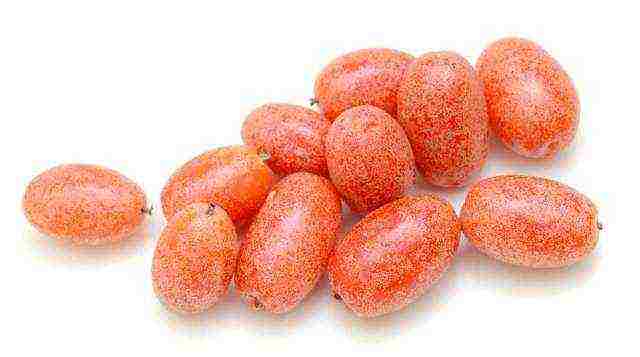
Gumi fruit
Considering that this shrub bears fruit on old shoots, it is recommended for the winter. harbor... To do this, the shoots are bent to the ground, fixed with metal brackets and covered with brushwood, burlap, spruce branches or non-woven material.
When covered with a film, gumi can vanish.
Loch multiflorous responds well to mulching with rotted compost.
You can learn more about mulching in our detailed resource All you need to know about mulch.
In constant pruning gumi does not need. It is enough to regularly remove damaged and frozen shoots. Rejuvenating pruning will have to be done only in the 13-15th year of life. For this, every third perennial shoot is cut into a ring.
Loch multiflorous is valuable because it attracts a large number of bees, as well as contributes to the enrichment of the soil with nitrogen... Its root system is superficial, and nitrogen-fixing nodules are located on the roots. A very compelling reason to plant this shrub in your garden!
Dereza Chinese
You, of course, more than once came across information about the almost miraculous properties of the berries of this shrub - goji... Whether they really contribute to weight loss is a controversial issue, but their benefits for the body have been proven by doctors.
Dereza Chinese, or ordinary, is guaranteed to tolerate frosts down to –15 ° C, and according to some reports, even up to –25 ° C. If the climate in your area is not sustainable, try grow this shrub in containers, and for the winter to bring to the basement or cellar.
In warm regions, Dereza can be planted in the fall, until early October. In the middle lane, this is only appropriate when growing in containers. If you are going to plant the tree in open ground, it is advisable to wait until the end of April.

Goji is nothing more than an ordinary Dereza

Chinese Dereza blooms almost all season
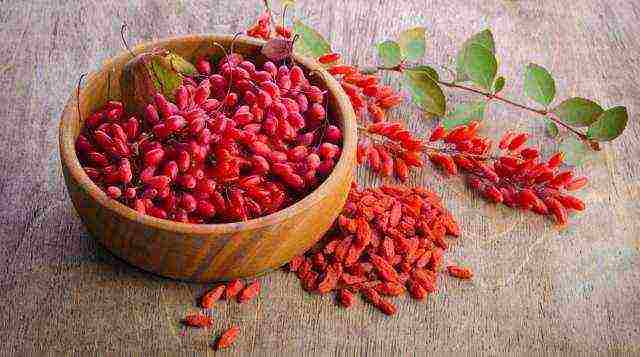
Dereza fruits are known for their medicinal properties
For landing choose a drained area on the south or southwest side. The type and composition of the soil is not critical.
The size of the planting pit is 50 × 40 cm. A distance of 1.5-2 m should be maintained between the seedlings. Fertilizers are applied for planting: 8 kg of rotted compost (humus and peat), 200 g of superphosphate, 40 g of potassium sulfate and wood ash from calculation for each landing pit.
The seedlings are buried by 5-7 cm. After planting, 30-40 liters of water are poured under each bush, after which the trunks are mulched with peat or humus.
Dereza, which is grown in containers, needs more frequent feeding and watering.
For the formation of ovaries, this shrub does not need pollinating plants, but, as in the case of gumi, when several bushes are planted nearby, the yield of dereza increases.
Dereza is very beautiful - it blooms all season, from late May to October. At the same time, lilac flowers are gradually replaced by oblong red fruits. During the summer, the harvest of berries can be harvested more than 10 times! The most valuable of them are considered to be collected at the end of summer, in August.
Perhaps the only significant drawback of this shrub is thorny shoots.
Duke
The fruit tree with the mysterious name duke is in fact nothing more than a hybrid obtained by crossing cherry and sweet cherry. Unlike cherry, duke boasts resistance to moniliosis and coccomycosis. It is distinguished from cherries by fruits with a slight sourness.

Duke is a hybrid of cherry and sweet cherry
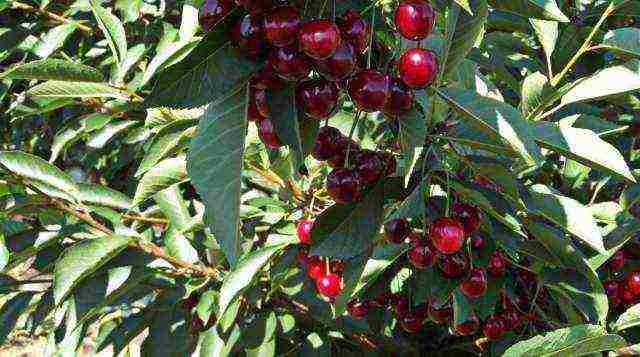
The first domestic duke hybrid was bred in 1888 by Michurin
Duke's winter hardiness is average. For the middle lane, varieties are best suited Ivanovna, Beauty of the North, Nochka-1, Nochka-2, Beautiful Venyaminova, Spartanka, Miracle cherry.
Nearby will certainly be planted cherry pollinator one of the following varieties: Iput, Red dense, Tyutchevka.
Dukeare planted to the sunniest, warmest place in the garden, with a fairly low level of groundwater. These plants do not thrive on acidified soil. Planting is no different from planting cherries and cherries. You can follow the advice of our article Planting a cherry seedling: detailed instructions for a beginner.
If the winter is very cold, the duke may not give a harvest at all, because it blooms and bears fruit on last year's shoots.
Cornel ordinary
Cornel is a spectacular bush-shaped fruit tree. It is interesting for its ultra-early flowering: this tree is covered with a scattering of bright yellow flowers even before the leaves hatch on it. Bloom lasts up to 3 weeks!
The color of dogwood fruits is most often scarlet, but they can be golden, pink and even black.
Unlike the plants listed above, this crop can tolerate slight shading... Shelter for the winter is required only at a young age.
Dogwood is one of the first to bloom in early spring

Dogwood fruits are tasty and healthy
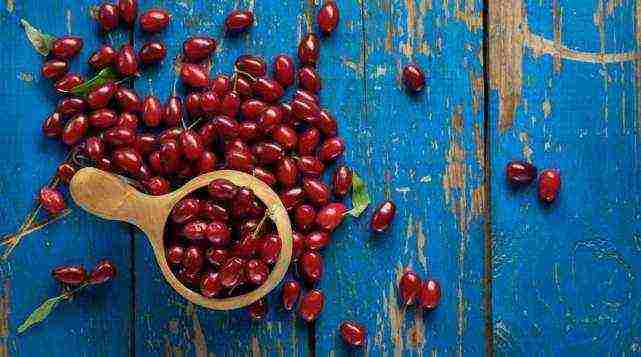
100 g of dogwood fruit contains the average daily intake of vitamin C
Planted dogwood in April, before bud break, or in September - early October, no later than 2-3 weeks before the onset of frost. The size of the planting pit is 80 × 80 cm. After planting, it is necessary to cut out every third shoot on a ring, water the seedlings at the rate of 30-40 liters for each bush and mulch the trunks.
Dogwood grows slowly, but really durable and not capricious. It remains only to puzzle over - why does he remain such a rare guest in our gardens?
Raspberry strawberry
This shrub is also called seductive raspberry. Its fruits really look like strawberries.
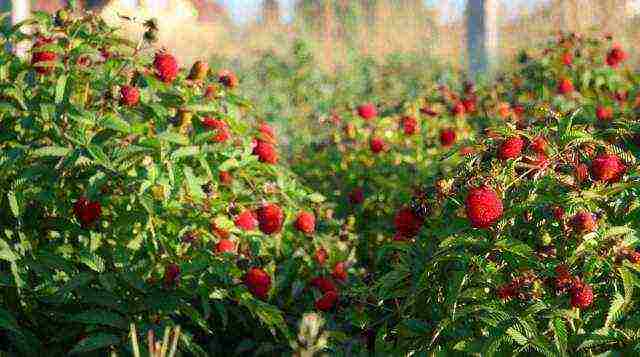
Strawberry raspberries can be grown as a hedge
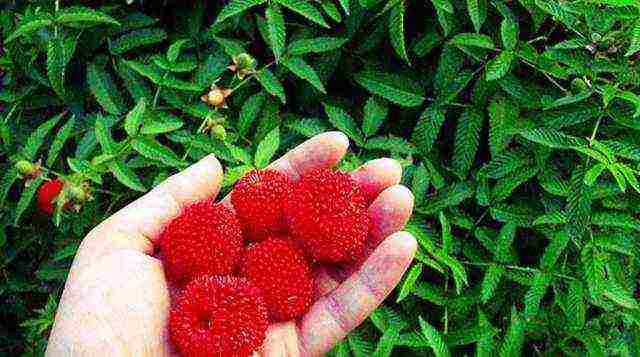
The fruits of this raspberry really look like strawberries.
The seductive raspberry has beautiful jagged leaves
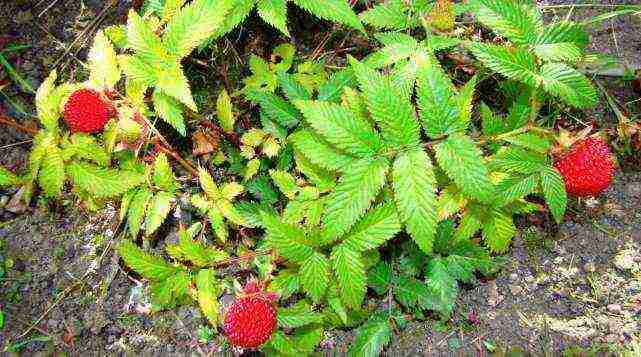
The bushes of this raspberry are short and very thorny.
The height of this shrub usually does not exceed half a meter. It grows quickly and forms curtains, so immediately upon planting it is desirable to limit the rhizome... For example, dig in slate around the perimeter of the landing pit. Otherwise, after a few years, your garden runs the risk of turning into a wild raspberry tree.
Strawberry raspberries bloom from June to September, with fruit ripening from July. Unfortunately, there are a lot of thorns on the shoots of this species, and harvesting is not an easy task. For this reason, the shrub is best grown as a hedge. Its beautiful foliage and long flowering make it an excellent ornamental plant.
Medlar
This tree loves mild winters and warm summers, so in the middle lane it are planted in the warmest corner of the garden, and for the winter, young plants are covered.
The medlar blooms in June with snow-white flowers. Fruits are small - about 3 cm in diameter, colored light brown. They taste sour, frankly, for an amateur. But they contain a large amount of nutrients and improve the condition of blood vessels.
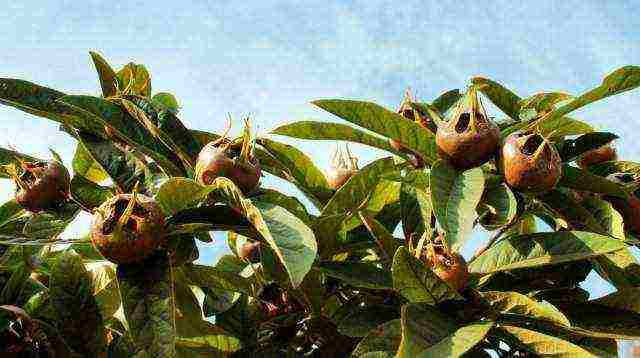
The German medlar can be grown in the middle lane, in contrast to the Japanese medlar
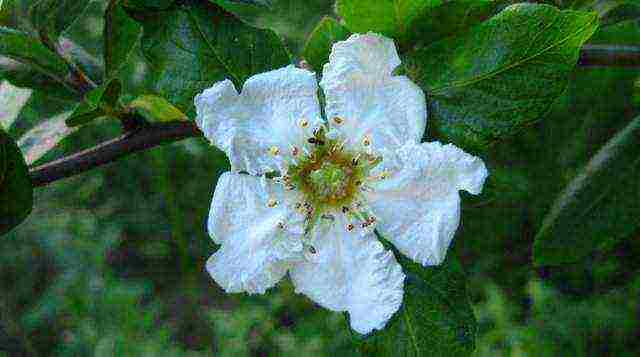
Flowering medlar german

The fruits of this type of medlar should not be eaten immediately after harvest.
By the way, you can't just eat the berries straight from the tree. Medlar fruits can be eaten only after 2-3 weeks of "aging"... To speed up the process, they can be frozen.
Under landing for seedlings of medlar, a hole is dug, a third larger in size than a clod of earth on the rhizome. Fill it with the following soil mixture: leafy earth, humus, turf and sand in equal parts.
Golden currant
Red currants, black currants, white currants - all these shrubs are well known to us. What about golden currants? The irony is that the color of the fruits on the bushes of this species is also quite varied: golden currants can be yellow, black, and red! It all depends on the variety.
This unusual shrub, unlike other currant bushes, can grow up to 2 m in height. The crown has a neat rounded shape. The leaves are similar to gooseberry leaves. In summer, the foliage is yellowish-green, and in autumn it changes color to burgundy-orange. Golden currant blooms with lemon-yellow flowers in late spring - early summer. In this case, flowering lasts up to 3 weeks.

Golden currants are in many ways more like gooseberries than currants.

Golden currants are in many ways more like gooseberries than currants.
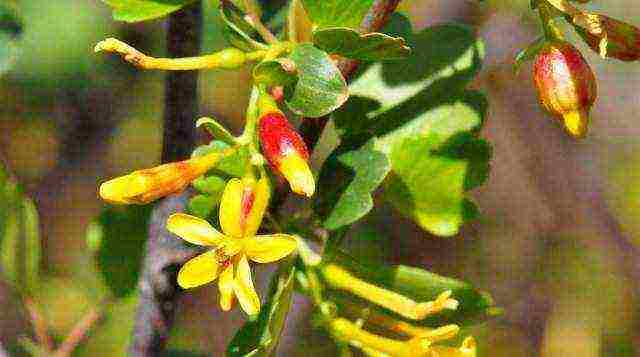
Golden currants are in many ways more like gooseberries than currants.
Golden currants are in many ways more like gooseberries than currants.
Berries of golden currant could be mistaken for a gooseberry, if not for the characteristic elongated shape and a "tail" of a dried pistil on one side.They are not sour to taste, unlike other types of currants, they are perfectly stored and transported thanks to their thick skin. From one bush, you can collect about 6 kg of the crop, and golden currant bears fruit for 20 years!
This plant is completely unpretentious: it tolerates return frosts, severe winters, drought, all kinds of "sores", is not afraid of partial shading. The main condition is not to plant a bush on waterlogged clay soils.
For landing dig a hole 50 × 50 cm in size, where 8 kg of rotted manure or compost, 200-300 g of superphosphate and 1.5 cups of ash are introduced. The root collar of the seedling should be buried 5-7 cm below ground level. After planting, the shoots are cut to 5-7 cm above the soil level.
In general, trimming the golden currant is optional, although it treats trimming well. But it can, for example, be formed in the form of a hedge or a low tree.
These facts have not convinced you to plant a few currant bushes on your site? Then here's another one for you: you don't need to cover the bush for the winter! In a word, he will not give you any trouble.
White mulberry
Mulberry is an oriental beauty that requires a place in the sun to maintain good "well-being". But, fortunately, the breeders managed to bring out several varieties that are quite adapted to the climate of the middle zone: White large, Smuglyanka, Black Baroness.
For fruiting, you need plant male and female plants nearby... Also note that the ovaries are formed on the shoots of the last year, therefore pruning worth carrying out without unnecessary fanaticism. It will be enough to remove damaged shoots and shorten healthy ones to give them the desired shape. The procedure is carried out in the spring before bud break, but the air must warm up to at least 10 ° C.
By the way, you can't do without pruning: if you don't "tame" the mulberry, then this "obstinate" can grow up to 12 m in height! Of course, given the slow growth rates, this will not happen in one season. For example, this crop brings its first harvest only in the 8-9th year after planting.
Luckily mulberry can also be grown as an ornamental plant... Therefore, a slow entry into fruiting should not be a problem at all - the tree will "work out" its place in the garden with a spectacular appearance.
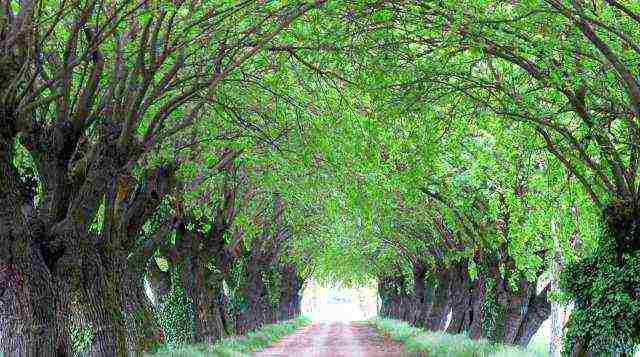
White mulberry can reach truly gigantic sizes

White mulberry
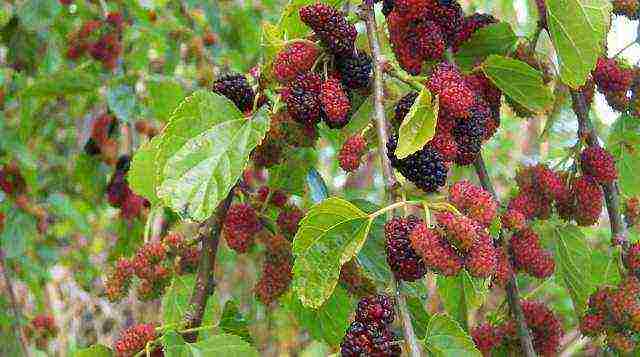
White mulberry
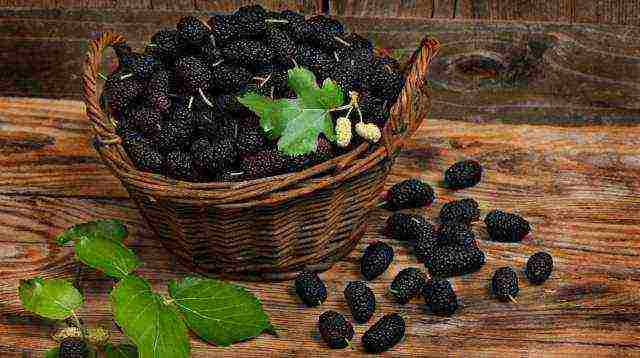
White mulberry
Mulberries are small, 2-3 cm long, fleshy, outwardly they resemble raspberries and blackberries. Depending on the variety, mulberries can be white, pink, red or dark-inked.
The skin of the berries is very delicate, so they quickly deteriorate and are stored for no more than 3 days, and even then in the refrigerator. It is advisable to eat them or put them for processing immediately after collection.
Plant mulberry seedlings in September - early October, no later than 2 weeks before the first frost, or in the second half of April. For planting, choose a warm, draft-free, sunny spot in your garden. The depth of the planting pit is at least 70 cm (the roots of the seedling should be freely placed in it, and the root collar should be deepened by about 5 cm).
200 g of superphosphate and 8-10 kg of rotted manure or compost are introduced into each planting pit. After planting, the seedling is watered with several buckets of water and mulched if necessary.
Mulberries can be successfully grown from seeds. For this, the seeds are left in the refrigerator for the winter, and in April they are sown in a greenhouse. By autumn, the height of the seedlings will reach 40 cm. Young plants are left to grow in a school until 1-2 years of age.
By the way, another advantage of mulberry is high drought tolerance.
Which of these trees or shrubs grow in your garden? Be sure to tell us in the comments!

Planting a new garden is an extremely demanding business.There are many factors to consider here, ranging from preferred varieties of fruit trees to comfortable placement on the site.
Some trees and shrubs make each other bad company, so this must also be considered when choosing suitable options. Basic recommendations and advice from experienced gardeners are given in our article.
From this article you can find out when you can plant fruit trees.
Site planning
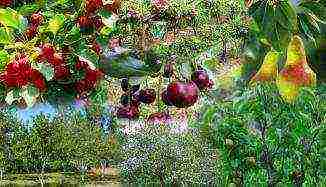
The first thing you need to pay attention to is the available area for the formation of the garden. Every tree and shrub needs a certain amount of space. If the cultivation of vegetables and other crops is also planned on the site, it is advisable to first delimit the location of future beds or greenhouses.
Experienced gardeners recommend choosing the south and east side for this. It is better to arrange low shrubs directly near the beds so as not to shade and not interfere with the growth of garden crops.
Trees are best planted after shrubs, for which a falling shadow will not pose a lot of problems. The minimum distance between trees is 4.5 - 5 meters. For shrubs, this value will be in the region of 1.5 - 2 meters. It is also necessary to stand at least 3-4 meters from nearby buildings and structures so that the root system does not damage the foundation.
When to spray fruit trees, see the article.
This also applies to building fire codes. Shrubs can be located one and a half meters from buildings. This also applies to other fixed structures: swimming pools, verandas and garden compositions.
The video shows fruit trees and shrubs for a garden plot:
Separate criteria for columnar plants that require much less space. Planting such varieties will not allow you to get record yields, but in a tight space it will be the best solution.
You can find out how to properly prune fruit trees by reading this article.
Previously, it is better to complete a schematic plan on paper, which will indicate the location of planned and existing buildings, already growing plantings, pedestrian paths and other objects. It is advisable to protect the place of the future garden from strong winds, fertilize the soil and make sure that there are no closely located groundwaters that will make it difficult to grow. 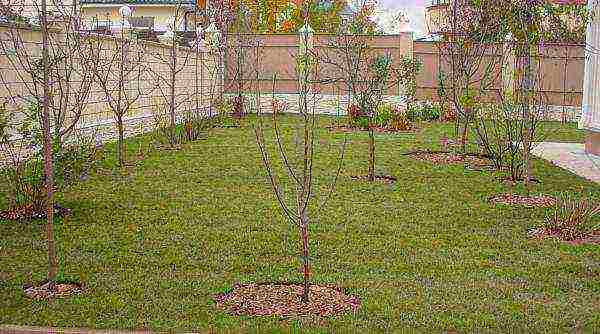
For a landscape arrangement, the most natural arrangement of crops is more suitable, while it is also necessary to pay due attention to ornamental plants and structures. If the site is small, but you want to arrange as many suitable crops as possible, it is better to give preference to a strict geometric planting plan. In this way, more diverse crops can be planted, but the general appearance will correspond to a practical, not decorative purpose.
In this article you can see a photo of Cherry Iput.
Illumination
Particular attention should be paid to the location of plantings according to the degree of illumination of the territory. Some trees and shrubs require a lot of sunlight, but for others, partial shade will be more comfortable.
Photophilous garden trees and shrubs:
- Pear.
- Apricot.
- Peach.
- Cherries.
- Plum.
- Rowan.
- Sea buckthorn.
- Quince.
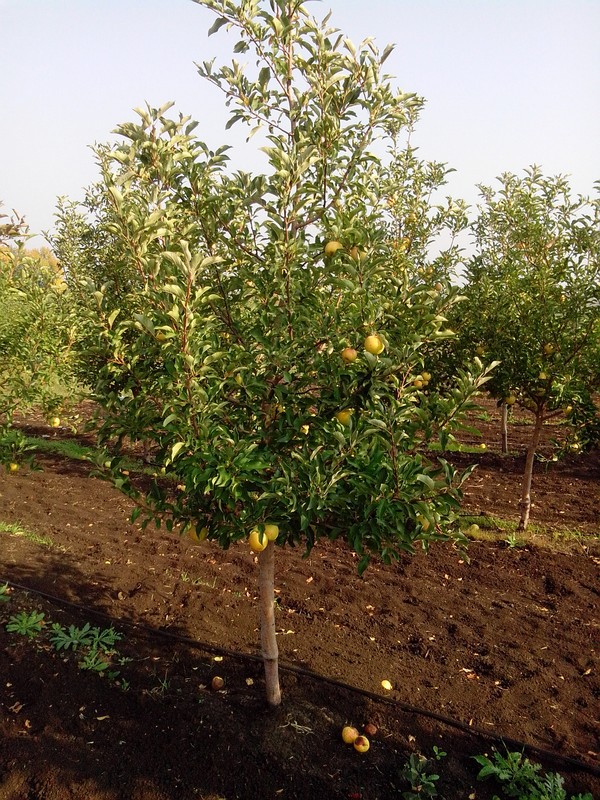
The rest of the shrubs and trees can grow with more or less equal success in the shade and in the sun.
Most shrubs thrive even with some shade, so you can alternate them with taller trees. An excellent option would be to land along the fence or along the perimeter of the building. In any case, it is necessary to maintain a comfortable distance between the plants.
How large, low-growing tomatoes look for open ground can be seen in this article.
What tall varieties of tomatoes for open ground are used is indicated in the article.
Which non-sticky tomato varieties for open ground are best used, you can find out here:
Which variety of large pink tomatoes is the best is indicated in the article.
And for those who want to grow not only trees, but also delicious vegetables in their garden, it is worth finding out what a determinant tomato variety means. Information is indicated in the article.
Among shade-tolerant crops, the following species are noted:
- Apple tree.
- Barberry.
- Kalina.
- Dogwood.
- Hazel.
- Elderberry is black.
- Raspberries.
- Blackberry.
- Honeysuckle.
- Gooseberry.
- Currant.
- Rose hip.
You should also not experiment with heat-loving crops in the middle zone or Siberia. The harvest on such plants simply does not have time to ripen and therefore such cultivation will not bring a positive result. In cooler climates, early varieties should be selected as well as specially adapted local varieties.
Planting incompatible crops in close proximity to each other is also a bad solution. How do you identify these options? The information below will help you with this.
The video shows fruit trees and bushes:
What plants can be planted nearbyPlant compatibility is an important factor on which possible breeding failures depend. There is a kind of classification according to which some types of trees cannot get along in close proximity to each other. The most unwanted neighbor turned out to be a walnut, which does not fit any tree or shrub as a companion.
Its dense crown blocks the sunlight, and its powerful root system prevents it from obtaining the necessary substances. In addition, the leaves contain a large amount of tannins, so they make the soil around them unsuitable for growing other plants. The minimum distance from a walnut for other plantings is 18 meters, so you should think twice before planting it in your area. Several similar examples are given below.
The video shows fruit trees and shrubs for the garden:
What crops are undesirable to plant next to:
- Apricot does not get along well with cherries, peaches and cherries.
- You cannot plant pear, apple and sweet cherry next to cherry plum.
- Cherry does not like close proximity to pear and apricot,
- If you decide to plant a hawthorn, don't place it next to a cherry.
- Pear reacts very capriciously to cherry plum, barberry, cherry, raspberry, plum and sweet cherry.
- The peach tree should not be planned near cherry, pear, apple and sweet cherry.
- Plum also does not like the neighborhood with cherries, pears and sweet cherries.
- The apple tree does not respond very well to the close location of apricots, barberries, cherries and raspberries.
- Raspberries, in turn, also cannot stand the pear and apple trees nearby.
Usually, most shrubs and trees get along well next to each other, if the required distance is consistent. There are exceptions to this rule, which are given earlier. At the same time, to ensure a comfortable growth of garden crops nearby, you can use another classification, which determines the plants that are most suitable for each other.
On the video - varieties of fruit trees and shrubs:
What crops can be grown side by side:
- Cherries willingly grow next to the apple tree.
- Barberry and plum are great neighbors.
- A pear and an apple tree get along well together.
- The plum will also be "delighted" by the close proximity to the apple tree.
- The following crops will have an ideal union with an apple tree: quince, pear, plum and most coniferous varieties.
In addition, two trees of the same type of different varieties go well with each other, which is why mono gardens are so popular. For sea buckthorn, it is advisable to plant several pollinating plants at once, as for some other crops: currants, raspberries and dogwood.
You don't have to call a landscape designer to create the perfect garden. Observing simple rules for the comfortable location of garden crops, and focusing on the preferences of plants in terms of illumination, you can easily plan the site yourself. For clarity, it is advisable to use a paper seating plan, on which you must first mark all buildings and general nuances of the area. Simple techniques and basic information about the possible location of popular cultures are given in our article.
By purchasing fruit trees and shrubs for a garden plot, its owner lays the foundation for truly strategic plantings. For many years to come, they determine the appearance of the territory adjacent to the house, and with proper care they become the main source of fruit crops.
What fruit and berry crops are most often of interest to gardeners? How to arrange the plants you like on the site and find the right neighborhood for them?
Fruit trees and shrubs: photos and names of popular crops
Due to the length of the country, which is spread over several natural zones at once, it is almost impossible to designate a single list of trees and shrubs. And yet there are species for which gardeners are sure to try to find a suitable place. Photos and names of these fruit trees and shrubs are well known even to those who are far from gardening.
Among fruit trees, the undisputed leaders are apple trees of different varieties and ripening periods. They are followed by pears and the most common stone fruits: cherries and plums.
Fruit and berry bushes, found almost everywhere, include raspberries, various types of currants, and gooseberries. Today it is actively gaining popularity:
- healing sea buckthorn;
- felt cherry;
- early honeysuckle.
Blackberries move to the orchard, more and more often on the plots you can find chokeberry, irgu and other crops, which some time ago were perceived as secondary or planted only for landscaping.
The list of shrubs for the garden is much broader than the above list of trees. No wonder. An orchard exclusively from trees will give its first harvest no earlier than 5-7 years, and the shrubs are ready to please the gardener already in the second or third year after planting.
An additional advantage of shrubs is their relatively small size and less laboriousness to care for. However, no one will be able to replace the pear with currants. Therefore, without trees, the garden will never be complete.
It is believed that in the northern regions, gardeners are limited in their choice by the harsh climate, but the further south, the more diverse the population of garden plots.
Indeed, starting from the Central black earth region, in the ranks of fruit and berry crops, it is not uncommon:
- apricot;
- cherry plum;
- mulberry;
- different types of nuts;
- cherry and its hybrid with cherry.
The list of shrubs is replenished with grapes, yoshta, dogwood and perennial fruiting vines.
But if until recently the gardeners of the middle lane and more northern regions were forced to be content with a very modest list of fruit and berry crops, today things are radically changing.
Nurseries have been successfully offering fruit trees and shrubs for the Moscow region for a long time, which were previously not available in the Non-Black Earth Region. The boundaries of the distribution of southern crops have seriously shifted to the north, not only due to climatic changes, but also thanks to the directed work of breeders.
It is this bait that inexperienced gardeners fall for, who want, by all means, to get a "Garden of Eden" in a limited area. You can understand them! But it is not enough to buy seedlings, it is important to plant and grow them correctly, taking into account all the requests of plants and the characteristics of the territory.
Rules for the placement of fruit trees and shrubs in the garden
Young saplings planted in the garden grow year after year.After a few years, when the time for fruiting comes, the crowns grow by 1.5–2 meters. And mature trees take up even more space.
It is not enough to choose the most winter-hardy, high-yielding varieties; it is necessary to accurately plan the future orchard.
It is better to do this on a piece of paper, based on measurements of the distances from the planting zone to the nearest buildings, roads, fences of neighboring properties. When planting fruit trees and shrubs in a garden plot, it is necessary to take into account not only the aesthetic preferences of the owner, but also the mandatory norms. They regulate the distance from large plants to residential and outbuildings, transport routes, communications and the boundary line passing between sections.
So, for example, from an apple tree or a pear to a residential building or garage should be at least 3.5-4 meters. This distance is explained by the safe operation of the building and the need for constant care for a large horticultural crop. For shrubs, the distance is less and is one and a half meters, which makes it possible:
- to freely carry out maintenance of walls, windows and other structures and communications;
- do not be afraid of excessive moisture in close contact with vegetation;
- take care of fruit and berry crops, harvest, cut and replant them.
In addition to the mandatory, common sense and safety restrictions, there are other rules that should be considered when planning an orchard.
It is extremely important to adhere to the distance between seedlings in rows, as well as take into account the deadline for growing a particular crop in one place.
Useful and harmful neighborhood of fruit trees and shrubs in the garden
Knowledge of the needs of individual plant species and their characteristics is of considerable importance for the future planting:
- Some crops prefer to grow in the sun, others easily adapt to the shade.
- For some of the fruit trees and shrubs in the garden area, an open, wind-blown place is suitable, and the other will have to find shelter.
- The demands of plants for fertility and watering vary.
It is unlikely that in the limited area of the site it will be possible to please all the requests of green pets. In a small country garden, inevitably some shrubs end up under the crowns of growing trees. So that such a neighborhood does not affect the yield, the meta for planting shade-loving fruit trees and shrubs in the garden is determined in advance.
These crops include black currants, honeysuckle, undersized, berry bushes such as cranberries, blueberries and lingonberries. If the shady corner of the garden is well ventilated, viburnum will settle well here. Blackberries and raspberries are grown in partial shade.
Gardeners have long noticed that even in comfortable conditions, garden plants sometimes refuse to bear fruit at full strength, look depressed and grow poorly. It turns out that the reason for this behavior is the wrong choice of neighborhood. As in nature, in an orchard, trees, shrubs and herbaceous crops form tight communities. The above options for a successful and dangerous neighborhood of fruit trees and shrubs in the table will help create the best conditions for each species and get the most out of it.
You can arrange the plantings so that closely related plants are nearby. This solution will be extremely useful, for example, for cherries and petioles, many varieties of which are self-fertile, and they need a pollinator to get a harvest. A similar picture is observed when growing sea buckthorn. True, here there must be one male bush for several female plants.
In addition, for sea buckthorn, which readily reproduces by root layers, blackberries and raspberries, it is better to find a place away from the rest of the garden plantings, otherwise the powerful shoots of these crops will master half of the garden in a year.
Fruit trees and berry bushes - video


